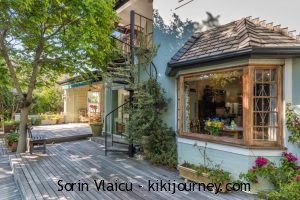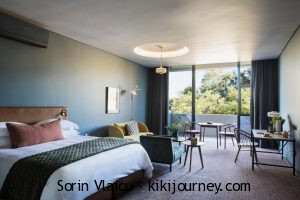Being the low – season in Cape Town, I did not expect the ferry boat tour to Robben Island to be fully booked. But the attempt to book online the tour failed due to two reasons. One way that it’s not possible to book 24h in advance on the official website. Secondly, it was fully booked for the next 48h and I did not have time to do it cause I was supposed to leave Cape Town.
There are 4 daily departures to Robben Island: Ferries depart at 9am, 11am, 1pm and 3pm, weather permitting, from Nelson Mandela Gateway, at the V&A Waterfront in Cape Town. And the price for the tour (tips not included) is 250 Rands – 25$.
But I said to myself that not all the tickets are to be sold online and some are sold offline. So, the next morning with my newly hostel made friends walked from our hostel to the Nelson Mandela Gateway Ticket Office at the V&A Waterfront, located next to the Yellow Watch Tower.
And another surprise was on the way. No tickets available offline, either! Well, imagine now, after the recent death of Nelson Mandela, how it would be. So, my suggestion is to book online within days of your arrival in Cape Town.
There were tickets available for the next day at 1pm. The tourists day for us was over and decided to take a stroll on the Waterfront and to have some coffee. Decided at well to come back at the office at noon to buy the tickets for the next day.
Midday come with another surprise. Make it 2! First, no more tickets available for next day either! One of the friends saw few people buying some tickets. We have asked for availably at the information desk, only. And the answer was the same: no more tickets. But at the box office, there were!
The boat was on the edge of departing. Actually, it was almost off. But 5 more tourists were coming. Yes, you guessed right. US, running and screaming: wait, wait, wait! On the deck, a voice was saying: stop! Slow down! It’s supposed it was not allowed to run on the deck.
So, finally on the boat to Robben Island. The trip takes around 40 minutes. If it’s cloudy, I suggest to stay inside cause if its cloudy can be a bit too windy for you. But if you stay outside you might see in the water some seals and dolphins!
And here I am. The place where Mandela was locked for almost 20 years. Robben Island has not only been used as a prison. It was a training and a defense station in World War II (1939-1945) and a hospital for people with leprosy, and the mentally and chronically ill (1846-1931). In the 1840s, Robben Island was chosen for a hospital because it was regarded as both secure (isolating dangerous cases) and healthy (providing a good environment for cure).
The name “Robben Island” was given by Dutch settlers and roughly translated means “Island of seals”. Was Declared a World Heritage Site in 1999. So another heritage site added to my list.
The prison was built in the 1960s, it was known as the hell-hole of apartheid. Nelson Mandela, who was imprisoned there for 18 years. Maybe people do make this mistake; in total Mandela spend 27 years in prison, but only 18 on Robben Island. The rest, he was locked in Jo’Burgh and Cape Town prisons.
The tour lasts 3,5 hours. But on the island will be for less an hour and a half. The first shock, even if it’s a harsh word, is how the tour is taking place. The first part is the only bus bus. We were put on 3 different buses and the guide started to explain us the history of the island and the prison. Our guide was a Jewish one, probably settled in South Africa long time ago. He was funny and did not speak about boring stuff. He even begged us to ask his question, otherwise he will be replaced by a TV and he will lose his job! [sam id=”48″ codes=”true”]
We passed one by one the Leper Graveyard, the churches build on the island (Desmond Tutu was there several times), the Old Airstrip, the school for the children of the people working on the island. But there were no more children there anymore. Due to lack of funds, now they have to go to school by ferryboat to Cape Town. That’s at least 2 hours one-way per day.
After the light, we stopped at the famous Limestone Quarry. This was used as a cement for the erection of the Cape Town Castle, as well as for whitewash. The lime quarry was made famous by the political prisoners who worked there with pick and spade in the 1960s, 1970s and 1980s. Harsh white light and heat in the quarry in summer and the long, wet winters made it an extremely uncomfortable space to work in. And did a lot of damage to their eyes, too.
Next to the prison is located The Kramat which commemorates one of the founders of Islam in South Africa. Sheikh Madura was exiled in the 1740’s and died on Robben Island. Many other ‘Indiaanen’ and ‘Mohammedaanen’ Muslim political prisoners from East Asia, were imprisoned here, including Tuan Guru, who became the first chief imam in South Africa.
There’s even a guest house on the Island. It’s opened only for the celebrities whom are visiting the place. Oprah was one of them, If I am not wrong.
The not so good about the tour was the fact that we were almost all the time on the bus. The pictures of the places had to be taken from the bus. I expected at least to go down at the quarry, but it did not happen. We set the foot on Robben Island, secondly, only at a short stop for some toilet emergency and photos with Cape Town behind us.
And here you are, at the prison’s gates. Our guide was a former inmate of the Robben Island Prison. Unfortunately, I do not remember his name. We were taken from Block A to Block C. And explained how the place was built and how life in prison was there.
I have visited several painful places: the Killing Fields in Cambodia, the War Memorials Museum in Phonsavan in Laos, the Uprising Museum in Warsaw, the Communist prison in Sighetu-Marmatiei in Romania or the S21 Prison in Phnom Penh. And in each place I felt the something. I felt grief and pain. And history; in the air, on the walls, surrounding the places.
At the Prison on Robben Island I did not feel anything. The place was clean, fresh and looked fresh painted. Lacked stories on the wall. Lacked history. Mandela spirit wasn’t there. Everything was just gray as the sky on that day. And I am pretty sure that I am not the only one thinking about it.
One more thing I did not understand it was when I passed the Mandela cell. Excepting the fact that I had to wait at least 5 minutes to take a photo, it was locked. I couldn’t get in. Why? All the prisons I have visited allowed us this thing. Even to use the beds. Mandela did not have one.
Maybe I had high expectation regarding the tour. I am not saying not to go. Now, after Mandela’s death, maybe his spirit will return there and the place will have that something. Don’t know. Will have to find out next time I will be visiting the island.
At the end, the souvenir stores were closed. People working on the island were taken some by the last ferry to Cape Town. The island will remain almost empty, desolated and with some few birds and seals.
To understand more about the place, the prison and the years Mandela spend it there I truly recommend to read his autobiography: The long Walk to Freedom.




















